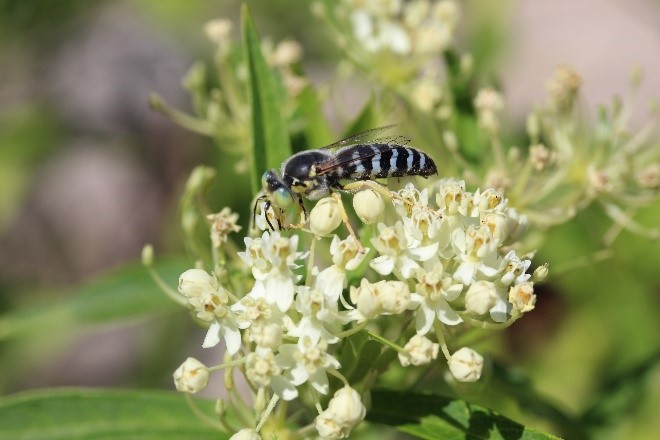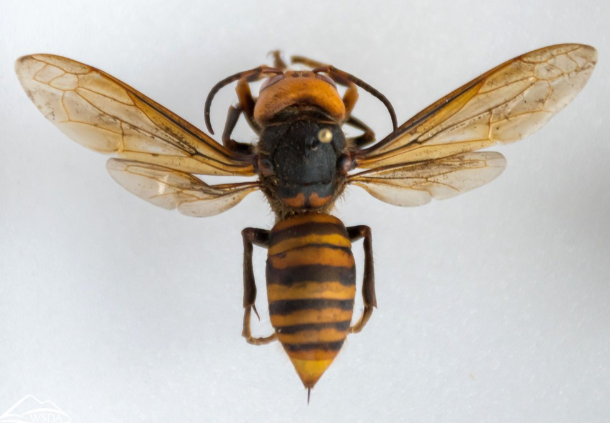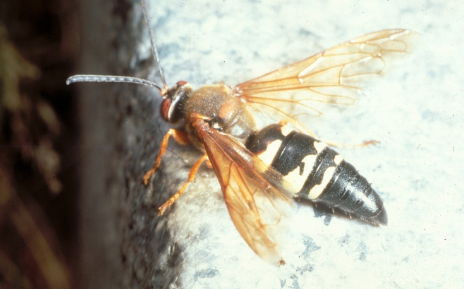From the Hort Desk – All About Wasps – Part I
- 2020-09-05
- By mkirk
- Posted in The Garden Buzz
By Lisa Mason, CSU Extension Horticulture Agent
It is September and you can feel the hint of autumn weather in the air. Autumn brings many joys like cool mornings, leaves changing colors, and garden harvests. One aspect you may not appreciate: Those pesky yellow jackets.

You may notice that yellow jackets start to become more aggressive in the fall. They are always defensive of their nesting site, but when fall arrives, they feel the cooler temperatures. Yellow jackets are scavengers. Food will become harder to find, and they may gravitate toward human sources of food such as your lunch or soda drink. They become defensive and aggressive near the food sources they find.
If yellow jacket wasps are a nuisance in your yard, hang in there! Yellow jacket and paper wasp colonies can’t survive the winter, so once the temperatures start getting colder, they will die off.
What is the purpose of wasps?
I am asked this question quite often. Why do we have wasps? What is their purpose?
Even though several species of wasps can be a nuisance to people, they play a critical role in our ecosystem.
Here are some important facts to know:
- Two species of wasps in Colorado are considered a nuisance: The Western yellow jacket (Vespula pensylvanica) and the European paper wasps (Polistes dominula).
- Besides those two species, wasps are a very diverse group of insects with thousands and thousands of species documented worldwide. How diverse? Current science says that beetles (Coleoptera) are the largest group of organisms on the planet representing about a quarter of all described species. However, some research suggests that parasitoid wasps are actually the largest group of organisms but we haven’t been able to document all the species. Here is a fun NPR article on subject.
- Many wasps can’t actually sting.
- Wasps provide valuable ecosystem services to humans because they provide pest control in the landscape. Some wasps are predators and others are parasitoids.
You can thank paper wasps for our current paper production industry. In the 1700s, paper was made from cotton and linen until there was a shortage of those materials. A French naturalist named Antoine Ferchault de Réaumer observed how paper wasps use wood fibers to make their paper nests and thought people could do the same thing to create paper. Paper products today are still made out of cellulose fibers from wood (Paulson and Eaton, 2018).

What about the “murder hornets”?
The Asian Giant Hornet (Vespa mandarinia), the world’s largest hornet, has been receiving a lot of press recently because a small number of individuals were found in Washington state. While the insect may look intimidating, much of the news media is sensationalized.
I encourage you to read a media interview with Dr. Cranshaw, CSU entomologist. He talks about how calling them “murder hornets” is unnecessary. Many wasps are predators and hunt other insects. The Asian Giant Hornet is no different. The term “murder hornet” makes this insect scarier than it needs to be.
Much of the media has focused on how Asian Giant Hornets prey on honey bees. While they can prey on honey bees, Asian Giant Hornets are generalist predators. They will feed on a variety of insects and will be opportunistic in hunting. They will not specifically target honey bees. Beekeepers have more important challenges concerning honey bees including the varroa mite.

Will the Asian Giant Hornet come to Colorado?
Short answer: No. We don’t have to worry about the Asian Giant Hornet coming to Colorado for the following reasons:
- Asian Giant Hornets thrive in different climate than Colorado. They need low-elevation areas and higher moisture levels.
- There are many geographic barriers preventing the Asian Giant Hornet from spreading including the Rocky Mountains.
- They are unlikely to hitchhike like some other invasive species.
- Efforts to eradicate the hornet is Washington are occurring now.
What if I find an Asian Giant Hornet in my backyard?
Colorado has some wasp species that are large and may appear to look similar to the Asian Giant Hornet. These wasps are harmless and common in Colorado landscapes. The two wasps that may look like the hornet include cicada killers and horntails. Both of these wasps cannot sting you.
Cicada killers target cicadas when hunting and provide the prey to their young.
Horntails appear to have a large “stinger.” This “stinger” can’t sting you at all. It is called an ovipositor, which is adapted to drill into the bark of trees. Female horntails lay their eggs underneath the bark of trees. They don’t harm trees and tend to lay eggs in trees that are already stressed out.

Stay tuned for more info on wasps!
I could write about wasps all day so look for a future article: All About Wasps – Part II. I will discuss the differences between social and solitary wasps, as well as some common and beneficial wasps you might see in your backyard.
Wasps can be scary to people for a variety of reasons, but I hope this article can help instill some appreciation for what all wasps contribute to our ecosystems.
3 Responses on “From the Hort Desk – All About Wasps – Part I”
Leave a Reply Cancel reply
Horticulture Resources
- Garden Buzz Archives
- CSU Extension Resources
- Colorado Master Gardener Program
- Foothills to Plains Native Plant Master Program
- Native Bee Watch Community Science Program
- The Co-Hort Blog
- PlantTalk Colorado
- Soil Testing
- Plant Select
- Emerald Ash Borer
- Japanese Beetle
- Colorado State Forest Service
- Ask an Expert



Hey Lisa!
I just watched with fascination tons of wasps on my sunflower plants. Interesting, though, as they weren’t going for the flower….they just walked along the stems and leaves. Are they eating, or ingesting material for nests? Or what? Thanks, sweet Lisa! 🙂
Great blogpost! Here at the CDA we are getting quite few calls and emails from concerned residents reporting what they believe is the AGH.
Here are the facts:
• They are not native to the United States.
• Asian Giant Hornets earned their nickname “Murder Hornet” because they decapitate honey bees, also not native to the United States.
• The Asian Giant Hornet has only been found in a specific area of Washington State.
• Within that area, 31 were found in 2020.
• In 2021, three were found prior to the location and eradication of a nest containing ~1,500 hornets.
It is important to note that Asian Giant Hornet has ??? been found outside of Washington State. While many individuals are reporting suspected Asian Giant Hornets, what they are most often seeing are either the Cicada Killer, or the Bald Faced Hornet. (Images courtesy NC State Extension.)
What to do if you suspect you have seen an Asian Giant Hornet:
• Keep calm. Odds are likely that what you have seen is one of the wasps below.
• If you still believe that what you have seen is an Asian Giant
Hornet, take a photo or try to capture it in a jar or plastic zip lock bag.
•Take the sample specimen or email the photo to your county Extension office. They will need:
• the date
• location
• your name and contact info.
Or,
• Bring the specimen or email the photos to your state Department of Agriculture with the same information as above.
#murderhornet #agriculture #media
Hello there,
Lovely article, thank you! I wonder if I could get some help from you with the visitor I had in my bathroom last night 🙂 It appears to be a hornet or a yellow jacket, although the photos online don’t correspond exactly to the suspect at hand. I kept it under a glass with plenty of air overnight and I’m now trying to figure out what to do with it. Don’t want to release it outside if it will instantly kill it. It’s long, large, black and yellow and not defensively striated. We are in Aspen, Colorado. What does a girl do?